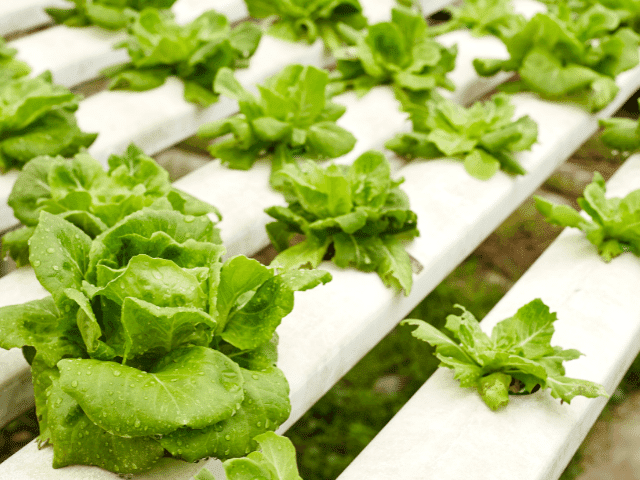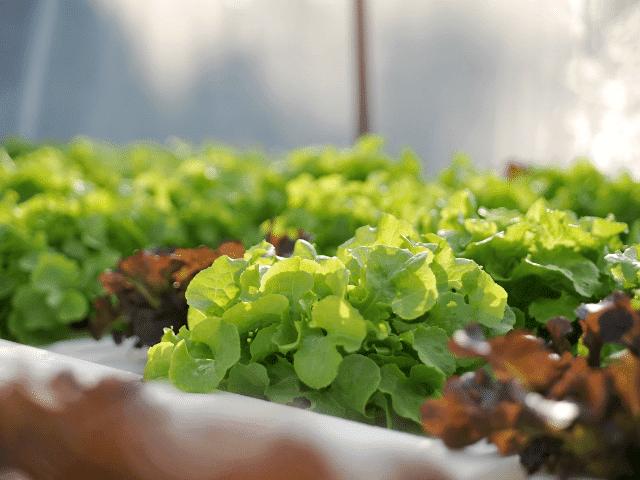Growing plants directly in water without soil
Growing and eating local is a great way to fight carbon costs of food transportation. Tomatoes flown in from a thousand miles away vs tomatoes grown in the backyard? The ones grown in your backyard will win in terms of carbon costs because the ones that traveled incur a carbon cost of transport that is hundreds of grams of CO2 per kilometer. There are a lot of ways to make sustainable backyard gardens and the hydroponic ecosystem is one we’ll look at in this article.
A hydroponic ecosystem is a system where plants are grown without soil in a water-based solution. The most common type of hydroponic system is the deep water culture system, which involves suspending the plant roots in a nutrient-rich solution. The solution is typically oxygenated and circulated using an air pump. The deep water culture system is one of the simplest and most efficient ways to grow plants hydroponically.
DIY complete hydroponic systems
You can do it on your own with some basic equipment and knowledge, or you can purchase a complete hydroponic system. Hydroponic systems can be as simple or as complex as you want them to be. You can grow various hydroponically, from lettuce and tomatoes to flowers and trees.
Hydroponics is a great way to grow plants because it allows you to control the environment and the nutrients the plants receive. You can use hydroponic systems to grow plants indoors or outdoors. They are also very efficient because the roots of the plants are in direct contact with the nutrient solution. This means that the plants can absorb more nutrients and grow faster than in soil.

Hydroponic ecosystem types
Hydroponic ecosystems come in all shapes and sizes. Some are small and simple, while others are large and complex. The type of hydroponic ecosystem you choose will depend on your needs and preferences.
Deep water culture
This system, also known as DWC, is the easiest to get started and cheapest to set up. We recommend you start here if you’re just learning to get into hydroponics. The plants are put into a plastic basket-style pot which lets water in and out, which is put into a water reservoir that contains the nutrient solution. An air hose and pump will move water and air bubbles that keep the plants experience fresh nutrient solution.
There are two key things to remember. First, the reservoir is quite sizable and the roots are submerged. In general the plant roots will not do well without air getting to the roots as they would in the soil. The way to solve this is to oxygenate with an air pump and air stone. The two together will move enough oxygenated water around to keep the submerged roots happy. Second, the nutrients at the right concentrations will be very stabilizing to the plants because of the high volume of the reservoir. This means less work for the grower.
Nutrient film technique
One of the most common types of hydroponic ecosystems is the nutrient film technique (NFT). This system consists of a shallow water reservoir, a growing medium, and a delivery system that transports nutrients to the plants. NFT systems are relatively easy to set up and maintain, making them a good choice for beginners.

Wick system
Another popular option is the wick system. This system uses a wick to transport nutrients from the reservoir to the plants. Wick systems are simple and efficient but can be less reliable than other systems.

Drip system
The drip system may be a good option for those looking for a more complex system. Drip systems deliver nutrients directly to the plant’s roots using a tubing and pump network. These systems can be complex to set up and maintain, but they offer a high degree of control over the growing environment.
Airi gap system
Finally we mention the air-gap system. The plant’s roots have a two-phase exposure: the lower tips touch the water to absorb nutrients in the water; the upper parts are exposed to air, which gives access to oxygen. Plants that have their roots in soil access oxygen via small air pockets or “air pores” in the soil. Similarly, in a hydroponic system a portion of the roots benefit from access to oxygen in the air.

No matter what type of hydroponic ecosystem you choose, you can be sure that you will be able to grow healthy and vibrant plants.
Essential nutrients of hydroponic systems are managed by water
There’s no need for soil. Therefore, what remains needed is good light, exposure to natural air, and water. Since soil is the substrate that supplies minerals for regular terrestrial plants, and since nutrients aren’t available through the air, water is the only other medium that we control for getting minerals and nutrients into a plant.
The ones that growers have to worry about most are the following essential ones:
- Phosphorus
- Nitrogen
- Calcium
These following two are necessary and needed in smaller amounts:
- Sulfur
- Magnesium
Of the remaining essential nutrients, carbon and oxygen, plants are able to access through the air.
Benefits of hydroponics
Hydroponics is a method of growing plants in a water-based solution without using soil. While this type of gardening has been around for centuries, it has recently gained popularity as a way to grow healthy plants without using traditional methods. Hydroponics has many benefits, including the following:
1. Increased growth rates
Plants grown in a hydroponic system often grow faster than those grown in soil due to the high packing density of growing plants very close to each other, and a consistent availability of nutrients via the water. This way of gardening also allows for year-round growing, as plants can be grown indoors under controlled conditions. The most critical elements that shape the controlled condition are the amount and type of light with the right wavelengths, nutrients in the water, and pH of the water.
2. Better water conservation:
Since hydroponic systems do not rely on soil, they can be much more efficient in their water use. Some estimates suggest that hydroponic gardens use up to 10 times less water than traditional soil-based gardens.
3. Better pest and disease control:
Plants grown in a hydroponic system are not subject to the same pests and diseases that often affect plants grown in soil. This is because the growing environment is much cleaner and more controlled.
4. More nutrients for plants
Plants grown in a hydroponic system have access to a constant supply of nutrients, which results in nutrient-rich fruits and vegetables. Hydroponically grown plants often have higher levels of vitamins and minerals than plants grown in soil.
5. Saves more space
Hydroponic systems can be set up in small spaces by densely packing the plants, making them a great option for those who do not have a lot of room to garden. They can also easily scale up or down to meet your space needs.
6. Local growth to reduce the transportation footprint
Hydroponic systems let grower farm from start to finish in a local place. Since harvesting happens locally, this avoids having to transport food from faraway plans. Food transportation costs are a burden on our carbon footprint.
With so many benefits, it is no wonder that hydroponics is gaining popularity among gardeners and farmers. Whether you are looking to increase your yield or simply want to try something new, hydroponics may be the perfect solution for you.
Why do we need hydroponics
Hydroponics is a method of growing plants in a water-based solution rather than in soil. This gardening has many benefits, including growing plants in a smaller space, controlling the nutrient levels more easily, and reducing the risk of pests and diseases. You can use hydroponics to grow a wide variety of plants, from herbs and vegetables to flowers and trees.
It is also possible to grow hydroponic plants indoors, making it an ideal option for those who do not have access to an outdoor garden. Hydroponic gardening is a great way to start gardening, as it is relatively easy to set up and does not require a lot of space or equipment. In addition, hydroponics is an eco-friendly option as it does not require the use of pesticides or other harmful chemicals.

Is hydroponics sustainable?
The jury is still out on this one. Hydroponics is a method of growing plants in water instead of soil. This type of agriculture has some advantages over traditional farming, but it also has its drawbacks.
On the plus side, hydroponic systems can be very efficient with water usage. Because the roots are constantly immersed in water, there is very little evaporation or runoff. This is good news for farmers in drought-prone areas. In addition, hydroponic farms can be set up anywhere – even in cities where there is little space for traditional farming.
However, there are also some downsides to hydroponics. First of all, it can be a very energy-intensive process. Pumps and other equipment must run around the clock to keep the water flowing, and you must keep the plants under artificial lights. This makes hydroponic farms a major contributor to greenhouse gas emissions. Additionally, because hydroponic farms rely on man-made systems, they are vulnerable to power outages and other disruptions.
So, is hydroponics sustainable? The answer is not clear-cut. While this type of agriculture has some advantages, it also comes with high environmental costs.
Wrapping up
In conclusion, it’s easier than you think to get started with hydroponics. All you need is a little bit of space and some basic equipment. You can grow various plants using hydroponics, from herbs and vegetables to flowers and trees. With so many benefits, it is no wonder that hydroponics is gaining popularity among gardeners and farmers. Whether you are looking to increase your yield or simply want to try something new, hydroponics may be the perfect solution for you.
You can also read:
7 Unique Bamboo Electric Toothbrush Heads
10 Environmental School Supplies That Are Sustainable
What To Do With Stickers After Using Them?
7 Best Sustainable Products To Help Prevent Climate Change

Anne Lauer
Anna Lauer is a writer, gardener, and homesteader living in rural Wisconsin. She has written for Mother Earth News, Grit, and Hobby Farms magazines. Anna is writing a new book about growing your food for free and an ultimate guide to producing food at little to no cost. When she’s not writing or gardening, Anna enjoys spending time with her husband and two young daughters.
